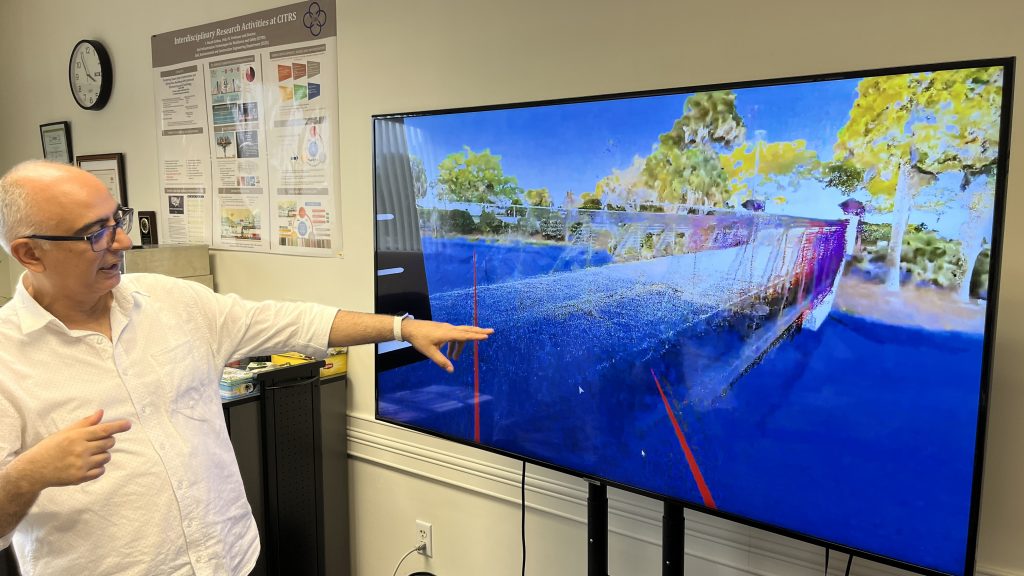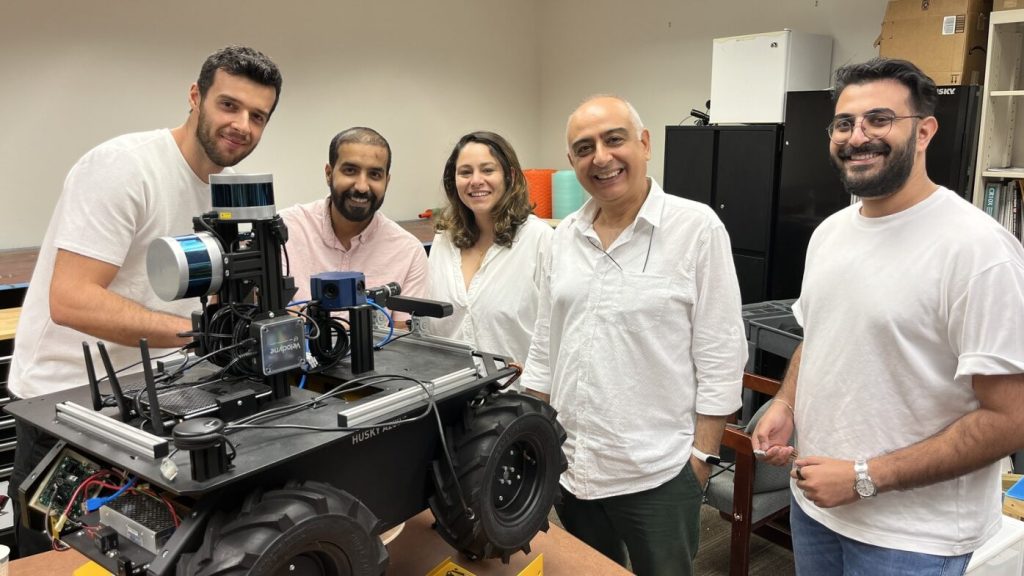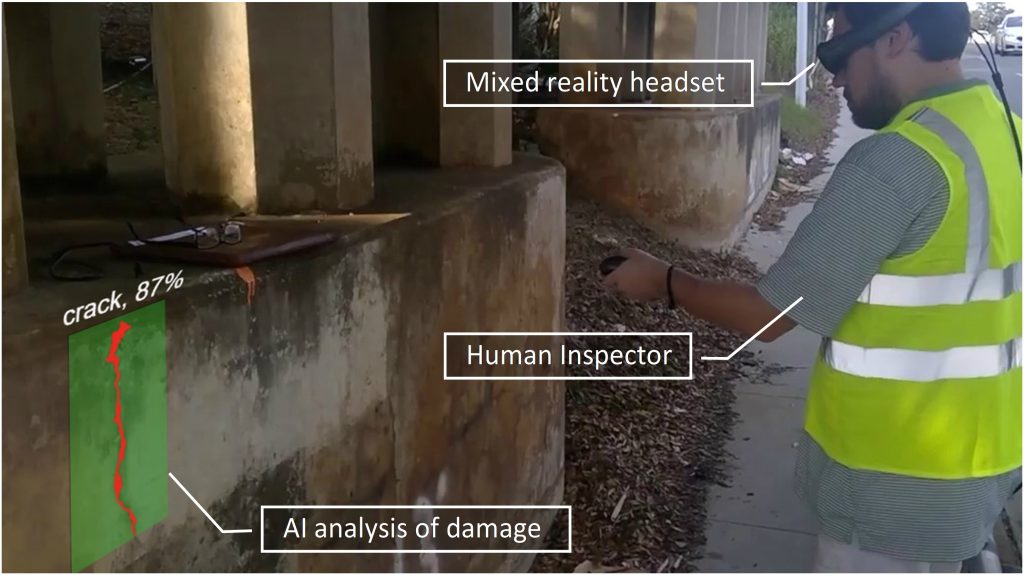Researcher Brings Innovations to Structural Health Monitoring
October 2023
By Kathleen Snoeblen
UCF Engineering Professor Necati Catbas has four inventions that he and his team developed to improve the structural health monitoring of buildings, bridges, roads and other civil structures.
“UCF is everywhere,” says long-time UCF Professor and researcher Necati Catbas. As proof, he recounted a chance meeting in Venice this summer, where he heard “Go Knights” while walking through the city with his family.
“I was wearing a UCF hat, and it was a UCF graduate and his family,” Catbas says. It was even more surprising since Catbas had just attended an engineering conference in Milan. There, he ran into UCF Dean Youcheng Wang of the Rosen College of Hospitality Management, who was attending another conference. “Next time I go, I’ll have a bigger UCF hat and T-shirts,” he says with a smile.

Figure 1. UCF Professor Necati Catbas, Department of Civil, Environmental, and Construction Engineering (CECE). Catbas was awarded the Aftab Mufti medal in 2015 at the International Conference on Structural Health Monitoring of Intelligent Infrastructure.
Catbas joined UCF’s Civil, Environmental and Construction Engineering (CECE) Department in 2003 and is the founding director of the Civil Infrastructure Technologies for Resilience and Safety (CITRS) Initiative at UCF. On sabbatical during his 20th year, Catbas is touring and lecturing at different universities and attending conferences.
“Over the last two decades, I have seen UCF’s name recognition and quality increase, from the productivity of our faculty to the new buildings to a new stadium,” he says. “So many, many things have happened,” he recalled.
“When I joined as a junior faculty, I brought a new research program in structural health monitoring and identification,” he says. “I have educated a number of structural engineers who are successfully practicing in Florida, in the U.S., and around the world, and several former doctoral students are professors, entrepreneurs, and top-level engineers. I am very proud about this.”
Monitoring the Health of Our Roads, Bridges and Buildings
UCF’s Office of Technology Transfer caught up with Catbas to learn more about Structural Health Monitoring (SHM) and four inventions that he and his team developed to improve the SHM of buildings, bridges, roads and other civil structures.
“Structural health monitoring is an area of need internationally,” Catbas says. “It’s almost like human health monitoring. You know, as we get older, monitoring our health becomes very, very critical.”
According to Catbas, civil infrastructure systems in developed countries are aging. “By better understanding their conditions, we can anticipate risks and better prioritize infrastructure investments,” he says.
He says that SHM technology is helpful for creating future smart structures and cities. Traditional monitoring methods include onsite visual inspection, which can be both time-consuming and costly with manual inspections and can create road and bridge traffic closures.
In addition to time and expense, sites with aging or damaged structures can also pose dangers to the general public and to those doing work at the site, even if they wear personal protective equipment. To address such issues, Catbas and his research team developed the technologies. “I am very lucky to have collaborated with many people who have expertise in SHM over the years, and I have to acknowledge their contribution,” he says. “It’s not a one-person effort.”
Monitoring Structural Health Using Computer Vision, Augmented/Virtual Reality
One invention Catbas and his team developed employs computer vision, while another uses augmented reality (AR) and virtual reality (VR).
“The idea of computer vision is to be able to use cameras as a complementary approach to using sensors,” Catbas says. “We can run tests and put sensors on structures to collect data with more cost-efficient systems, but that’s been for the last 15 years—maybe more—close to two decades.”
He noted that besides complementing sensors and visual inspection, computer vision is very practical because it doesn’t require access to structures such as bridges, buildings, towers. “We can use the camera, and by analyzing the images, we can extract meaningful information about these bridges and buildings,” he says.

Figure 2. Catbas shows the Virtual Visualization System. In the example, engineers located anywhere in the world with VR headsets are inspecting a particular bridge and seeing the structural health monitoring data simultaneously to aid their decision making.
The technology, a Comprehensive Structural Health Monitoring System, enables engineers and inspectors to safely evaluate the condition, view, and accurately assess the load-worthiness and serviceability of structures without having to be onsite.
Catbas says that the UCF invention uses cameras stationed on and around a structure (like a bridge) to collect image and location data related to the structure’s use. In the bridge example, the data relates to vehicles crossing the bridge. The data can include the vertical or horizontal displacement of girders caused by their movement, vibrational effects and velocity. While the cameras continually monitor the site, computer vision software processes and analyzes the collected data, providing system users with a safety assessment that includes information about structural changes and weaknesses, as well as immediate damage.
The second invention that the team developed is an Immersive Visualization System that uses VR and AR to analyze structures via “virtual visits.” VR provides a completely computer-simulated environment, while AR generates or overlays content onto actual views of a real-world environment.
“With this technology, you can virtually bring experts to disaster areas, such as buildings and bridges, like after a hurricane,” Catbas says. “I can virtually be on a damaged bridge [in Florida] discussing decisions with colleagues who might be in California.”
Like the first invention, the visualization system provides damage detection and load-carrying information about a structure using cameras and sensors. Additionally, it employs other tools such as robots, unmanned aerial vehicles (UAVs) or drones, LiDAR scanners, and infrared thermography cameras. With its visualization platform, the technology provides the collected data and images via a user interface and sophisticated computer graphics. The result is a real-time view of a site and the ability to interact and communicate with people from different locations: onsite, across the country, and even globally.
Enhancing Inspections and Structural Damage Diagnostics Using AI
The other two inventions developed by Catbas and his team incorporate artificial intelligence (AI). For instance, the Collective Intelligence Framework technology blends human-centric AI with mixed reality to help fast-track inspection processes and keep costs down while ensuring accuracy. With this invention, an inspector standing outside a damaged building could wear a headset and/or use a hand-held device integrated with the technology.
Figure 3. Example depiction of a bridge inspection using an AI-powered mixed reality system.
The inspector uses the items to scan the damaged areas, which the system analyzes in real-time, saving the inspector from having to perform manual measurements. It then calculates or assesses the building’s condition, thus speeding the inspection process. During the assessment, the inspector interacts with the AI and can adjust its defect and detection boundaries. The system uses the inspector’s changes to retrain the AI model so that the AI’s accuracy improves over time. A major advantage of the invention is its ability to combine the professional judgment of an inspector/engineer with the AI’s analytical power.
Lastly, Catbas says that the Generative Adversarial Network invention enables a more proactive approach to managing and maintaining the health and safety of structures. It uses AI to predict damage and minimize the need for data collection from many structures.
“Instead of putting sensors and devices on all structures, we can collect data from just a few of them, yet make up for uncollected data,” Catbas says.
He explained that collecting useful data from sensors about damaged structures is expensive and challenging. “There is not enough data from damaged areas to train detection models,” he says. Yet, machine learning (ML) and deep learning (DL) algorithms used with AI yield better, more accurate output using big data sets. As a solution to the data scarcity in civil SHM applications, the invention takes data collected from structures. It uses model variants of the GAN architecture to generate large, accurate synthetic data samples to train damage diagnostics systems. GAN is a generative-based DL model used in computer vision and AI.
“Then, by using AI, we can better understand what’s going on with other similar structures and more effectively decide how to respond,” he says.

Figure 4. Shown are some members of the UCF CITRS lab with the autonomous Husky robot “Cypector–the Cyber Inspector” (left to right): Furkan Lüleci, Inad Alqurashi, Mahta Zakaria, Dr. Necati Catbas, Abdulrrahman Algadi.
The technology can predict the dynamic response of a structure change before damage conditions occur. It’s also possible to create potential future conditions of structures, such as generating data showing what a healthy bridge’s response would be after damage compared to the response of an unhealthy bridge. It should be mentioned that this technology is not only limited to civil structures but also applicable to mechanical and aerospace structures.
Catbas says that the inventions can be used independently or together. For more information, view the technology sheets.
Upcoming Projects
Catbas says that his team’s future research plans include a framework for smart and resilient communities to withstand extreme events.
“It enhances community resilience by providing valuable insights for disaster preparedness, resource allocation, and evacuation planning,” he says. “The framework improves emergency management by enabling informed decision-making during crises.”
They are also developing a “digital twin” of infrastructure assets, like the way NASA uses replicas of spacecraft components.
“They have those components on the ground, and if something happens, they work with these replicas,” he says. “So, this twin, in a sense, allows us to collect data simultaneously and work on different structure scenarios using predictive analysis.”
Researcher’s Credentials
Catbas holds a doctorate in structural engineering from the University of Cincinnati. After postdoctoral studies at Drexel University in Philadelphia, he joined CECE in 2003 and is the founding director of the Civil Infrastructure Technologies for Resilience and Safety (CITRS) Initiative. His research covers various aspects of civil engineering, including analysis, design, and assessment of civil infrastructure systems, such as bridges, buildings, roadways, structural health monitoring, structural identification, and structural dynamics and earthquake engineering.
Technology Available for License
To learn more about Catbas’ work and additional potential licensing or sponsored research opportunities, contact Raju.Nagaiah (Raju.Nagaiah@ucf.edu) at (407)-882-0593.
